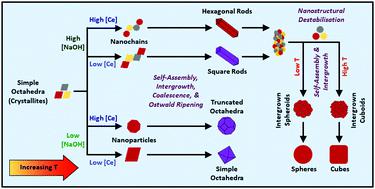当前位置:
X-MOL 学术
›
Mater. Horiz.
›
论文详情
Our official English website, www.x-mol.net, welcomes your feedback! (Note: you will need to create a separate account there.)
Design strategies for ceria nanomaterials: untangling key mechanistic concepts
Materials Horizons ( IF 13.3 ) Pub Date : 2020-09-28 , DOI: 10.1039/d0mh00654h Yuwen Xu 1 , Sajjad S Mofarah , Rashid Mehmood , Claudio Cazorla , Pramod Koshy , Charles C Sorrell
Materials Horizons ( IF 13.3 ) Pub Date : 2020-09-28 , DOI: 10.1039/d0mh00654h Yuwen Xu 1 , Sajjad S Mofarah , Rashid Mehmood , Claudio Cazorla , Pramod Koshy , Charles C Sorrell
Affiliation

|
The morphologies of ceria nanocrystals play an essential role in determining their redox and catalytic performances in many applications, yet the effects of synthesis variables on the formation of ceria nanoparticles of different morphologies and their related growth mechanisms have not been systematised. The design of these morphologies is underpinned by a range of fundamental parameters, including crystallography, optical mineralogy, the stabilities of exposed crystallographic planes, CeO2−x stoichiometry, phase equilibria, thermodynamics, defect equilibria, and the crystal growth mechanisms. These features are formalised and the key analytical methods used for analysing defects, particularly the critical oxygen vacancies, are surveyed, with the aim of providing a source of design parameters for the synthesis of nanocrystals, specifically CeO2−x. However, the most important aspect in the design of CeO2−x nanocrystals is an understanding of the roles of the main variables used for synthesis. While there is a substantial body of data on CeO2−x morphologies fabricated using low cerium concentrations ([Ce]) under different experimental conditions, the present work fully maps the effects of the relevant variables on the resultant CeO2−x morphologies in terms of the commonly used raw materials [Ce] (and [NO3−] in Ce(NO3)3·6H2O) as feedstock, [NaOH] as precipitating agent, temperature, and time (as well as the complementary vapour pressure). Through the combination of consideration of the published literature and the generation of key experimental data to fill in the gaps, a complete mechanistic description of the development of the main CeO2−x morphologies is illustrated. Further, the mechanisms of the conversion of nanochains into the two variants of nanorods, square and hexagonal, have been elucidated through crystallographic reasoning. Other key conclusions for the crystal growth process are the critical roles of (1) the formation of Ce(OH)4 crystallite nanochains as the precursors of nanorods and (2) the disassembly of the nanorods into Ce(OH)4 crystallites and NO3−-assisted reassembly into nanocubes (and nanospheres) as an unrecognised intermediate stage of crystal growth.
中文翻译:

二氧化铈纳米材料的设计策略:解开关键机械概念
二氧化铈纳米晶体的形态在决定其氧化还原和催化性能在许多应用中起着至关重要的作用,但合成变量对不同形态二氧化铈纳米颗粒形成及其相关生长机制的影响尚未系统化。这些形态的设计以一系列基本参数为基础,包括晶体学、光学矿物学、暴露晶面的稳定性、CeO 2− x化学计量、相平衡、热力学、缺陷平衡和晶体生长机制。对这些特征进行了形式化,并对用于分析缺陷,特别是临界氧空位的关键分析方法进行了调查,目的是为纳米晶体的合成,特别是 CeO 2- x的合成提供设计参数的来源。然而,CeO 2- x纳米晶体设计中最重要的方面是了解用于合成的主要变量的作用。虽然有大量关于 CeO 2− x的数据在不同的实验条件下使用低铈浓度 ([Ce]) 制造的形貌,目前的工作根据常用原材料 [Ce](和 [NO 3 - ] 在 Ce(NO 3 ) 3 ·6H 2 O) 中作为原料,[NaOH] 作为沉淀剂,温度和时间(以及互补的蒸气压)。通过结合已发表文献的考虑和关键实验数据的生成填补空白,完整的机理描述了主要CeO 2− x的发展形态说明。此外,已通过晶体学推理阐明了将纳米链转化为纳米棒的两种变体(方形和六边形)的机制。晶体生长过程的其他关键结论是(1)作为纳米棒前体的 Ce(OH) 4微晶纳米链的形成和(2)纳米棒分解成 Ce(OH) 4微晶和 NO 3的关键作用-辅助重组成纳米立方体(和纳米球),作为晶体生长的一个未被识别的中间阶段。
更新日期:2020-11-27
中文翻译:

二氧化铈纳米材料的设计策略:解开关键机械概念
二氧化铈纳米晶体的形态在决定其氧化还原和催化性能在许多应用中起着至关重要的作用,但合成变量对不同形态二氧化铈纳米颗粒形成及其相关生长机制的影响尚未系统化。这些形态的设计以一系列基本参数为基础,包括晶体学、光学矿物学、暴露晶面的稳定性、CeO 2− x化学计量、相平衡、热力学、缺陷平衡和晶体生长机制。对这些特征进行了形式化,并对用于分析缺陷,特别是临界氧空位的关键分析方法进行了调查,目的是为纳米晶体的合成,特别是 CeO 2- x的合成提供设计参数的来源。然而,CeO 2- x纳米晶体设计中最重要的方面是了解用于合成的主要变量的作用。虽然有大量关于 CeO 2− x的数据在不同的实验条件下使用低铈浓度 ([Ce]) 制造的形貌,目前的工作根据常用原材料 [Ce](和 [NO 3 - ] 在 Ce(NO 3 ) 3 ·6H 2 O) 中作为原料,[NaOH] 作为沉淀剂,温度和时间(以及互补的蒸气压)。通过结合已发表文献的考虑和关键实验数据的生成填补空白,完整的机理描述了主要CeO 2− x的发展形态说明。此外,已通过晶体学推理阐明了将纳米链转化为纳米棒的两种变体(方形和六边形)的机制。晶体生长过程的其他关键结论是(1)作为纳米棒前体的 Ce(OH) 4微晶纳米链的形成和(2)纳米棒分解成 Ce(OH) 4微晶和 NO 3的关键作用-辅助重组成纳米立方体(和纳米球),作为晶体生长的一个未被识别的中间阶段。



























 京公网安备 11010802027423号
京公网安备 11010802027423号